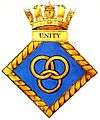HMS Unity (N66)
 HMS Unity | |
| History | |
|---|---|
| Name: | HMS Unity |
| Builder: | Vickers Armstrong, Barrow-in-Furness |
| Laid down: | 19 February 1937 |
| Launched: | 16 February 1938 |
| Commissioned: | 5 October 1938 |
| Fate: | Sunk 29 April 1940 in accidental collision |
| Badge: |
 |
| General characteristics | |
| Class and type: | U-class submarine |
| Displacement: |
|
| Length: | 58.22 m (191 ft 0 in) |
| Beam: | 4.90 m (16 ft 1 in) |
| Draught: | 4.62 m (15 ft 2 in) |
| Propulsion: |
|
| Speed: |
|
| Complement: | 27 |
| Armament: |
|
HMS Unity was a U-class submarine, of the first group of that class constructed for the Royal Navy. The submarine entered service in 1938 and performed war patrols during the Second World War. On 29 April 1940, Unity was accidentally rammed and sunk in Blyth, Northumberland's harbour.
Construction and career
Unity was built by Vickers Armstrong, Barrow-in-Furness. She was laid down on 19 February 1937 and was commissioned on 5 October 1938.
At the onset of the Second World War, Unity was a member of the 6th Submarine Flotilla. From 26-29 August 1939, the flotilla deployed to its war bases at Dundee and Blyth.[1] She served in home waters in the North Sea, making a failed attack on the German submarine U-2.[2]
Sinking
Unity sailed from Blyth on 29 April 1940 to patrol off Norway. The visibility was down to 300 yards (270 m) as Unity moved out of the harbour into the main channel, where the Norwegian ship Atle Jarl was proceeding on her way from Scotland to the Tyne. A short while later visibility was down to 100 yards (91 m) and neither vessel was aware of the other until the submarine spotted the Atle Jarl at 50 yards (46 m) on a collision course. There was just time to shut the bulkhead doors and order the engines astern before Atle Jarl smashed into the submarine. The order to abandon the submarine was given and Unity sank only five minutes after the collision.[3] Two members of her crew, Lieutenant John Low and able Seaman Henry Miller, gave their lives by remaining behind in the flooded control room so that their shipmates could escape from the sinking vessel.[4]
See also
References
- ↑ Rohwer, p.1
- ↑ "HMS Unity (N 66)". uboat.net. Retrieved 9 April 2016.
- ↑ "Submarine losses 1904 to present day". RN Submarine Museum, Gosport. Archived from the original on August 8, 2007.
- ↑ Gray, p.180
Sources
- Colledge, J. J.; Warlow, Ben (2006) [1969]. Ships of the Royal Navy: The Complete Record of all Fighting Ships of the Royal Navy (Rev. ed.). London: Chatham Publishing. ISBN 978-1-86176-281-8. OCLC 67375475.
- Gray, Edwyn (1996). Few Survived A Comprehensive Survey of Submarine Accidents and Disasters. London: Leo Cooper. ISBN 978-0850524994.
- Hutchinson, Robert (2001). Jane's Submarines: War Beneath the Waves from 1776 to the Present Day. London: HarperCollins. ISBN 978-0-00-710558-8. OCLC 53783010.
- Rohwer, Jürgen (2005). Chronology of the War at Sea 1939—1945: The Naval History of World War Two (Revised & Expanded ed.). Annapolis, Maryland: Naval Institute Press. ISBN 1-59114-119-2.
Coordinates: 55°13′N 1°19′W / 55.217°N 1.317°W